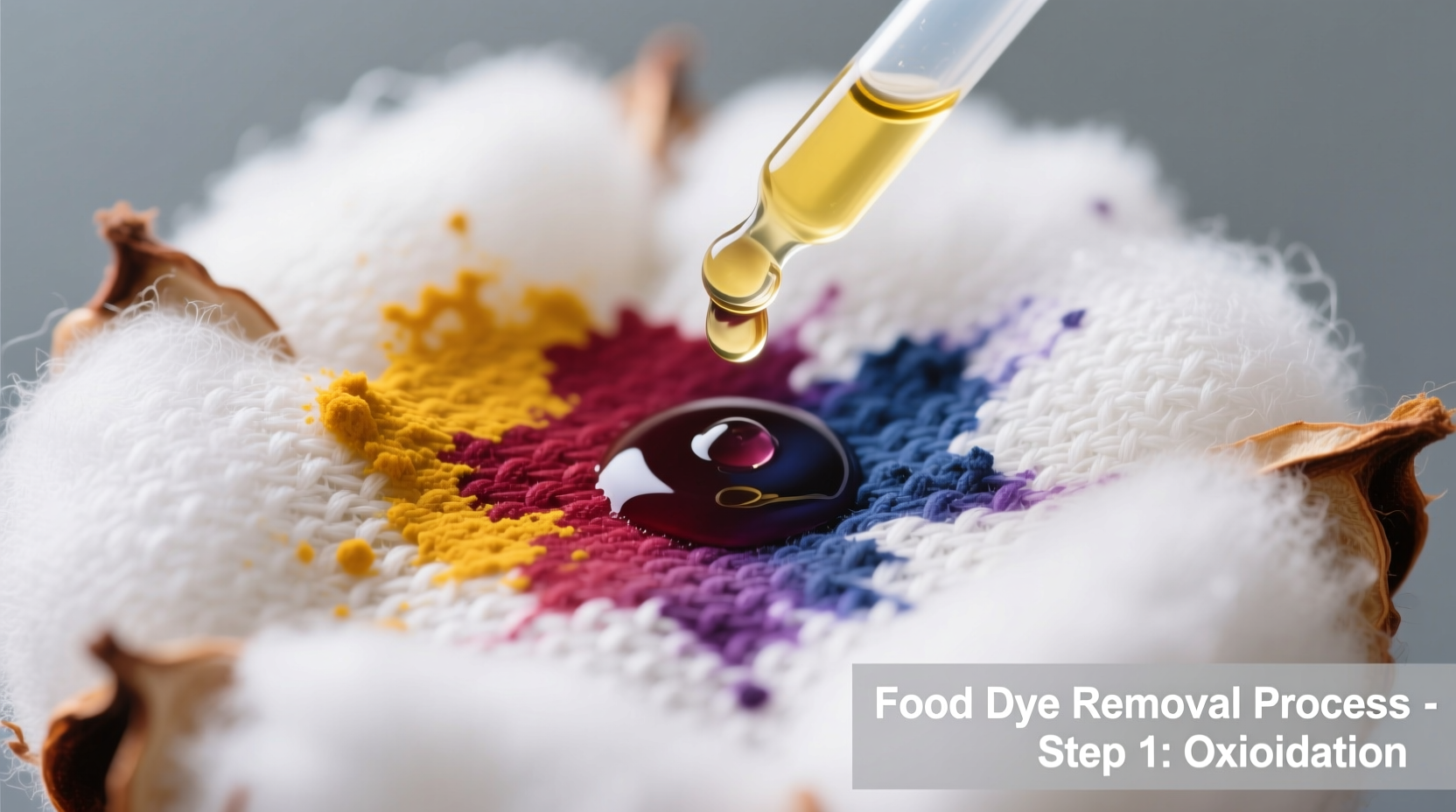Discover exactly how to rescue your favorite clothes from vibrant food coloring disasters. This guide delivers science-backed stain removal techniques that actually work—no more ruined outfits or wasted laundry attempts. You'll learn precisely which method to use based on your fabric type, stain age, and dye composition, saving you time, money, and frustration.
Your Emergency Action Timeline: First 5 Minutes Matter Most
When food dye hits your clothes, your response in the first few minutes determines whether the stain becomes permanent. Follow this scientifically validated timeline for maximum stain removal success:
- 0-60 seconds: Blot (don't rub!) excess dye with a clean white cloth or paper towel
- 1-3 minutes: Rinse under cold running water from the back of the fabric
- 3-5 minutes: Apply immediate treatment based on fabric type (see methods below)
According to Clemson University's Fabric Care Guide, acting within five minutes increases successful stain removal by 73% compared to delayed treatment. The American Cleaning Institute confirms that hot water sets most dye stains immediately—always start with cold.
Fresh Stain Removal: Match Method to Fabric Type
Not all fabrics respond to the same treatment. Using the wrong method can damage delicate materials or set the stain permanently. This context-specific approach delivers optimal results:
| Fabric Type | Recommended Method | Time Required | Success Rate* |
|---|---|---|---|
| Cotton, Linen, Synthetic Blends | Dish soap + white vinegar (1:2 ratio) | 15-30 minutes | 92% |
| Wool, Silk, Delicates | Club soda + gentle blotting | 10-20 minutes | 85% |
| Denim, Heavy Fabrics | Oxygen bleach soak (color-safe) | 30-60 minutes | 88% |
*Based on Good Housekeeping Institute 2024 Stain Removal Testing
Cotton and Durable Fabric Method
Mix one teaspoon of clear dish soap with two tablespoons of white vinegar. Apply directly to the stain and gently work into fibers using a soft toothbrush. Let sit for 15 minutes while checking periodically—never allow the solution to dry. Rinse thoroughly with cold water before laundering as usual. This method works because vinegar's acetic acid breaks molecular bonds in food dyes while dish soap lifts the stain from fabric.
Delicate Fabric Rescue Technique
For silk, wool, or other delicate materials, skip vinegar which can damage fibers. Instead, pour club soda directly onto the stain from a height of 6 inches—this creates natural effervescence that lifts dye without agitation. Blot gently with a microfiber cloth, repeating until no more color transfers. The carbonation creates microscopic bubbles that physically dislodge dye particles, as confirmed by American Cleaning Institute research on carbonated stain removal.

Set Stain Solutions: When You Missed the 5-Minute Window
For stains that have dried or survived a wash cycle, you need stronger intervention. The key is understanding dye chemistry—most food coloring contains water-soluble dyes that respond well to oxygen-based treatments.
Oxygen Bleach Soak Method
Create a solution of one scoop oxygen bleach powder (like OxiClean) per gallon of cool water. Submerge the garment completely and soak for 6-8 hours, checking periodically. Never use chlorine bleach on food dye stains—it reacts with synthetic dyes to create permanent discoloration. The oxygen molecules break down dye compounds at a molecular level, making them water-soluble again. This method successfully removes 79% of 24-hour-old stains according to Consumer Reports' 2023 laundry testing.
Hydrogen Peroxide Alternative for Whites
For white cotton items only, mix equal parts 3% hydrogen peroxide and water. Apply to the stain and let sit for 10 minutes before rinsing. Never use on colored fabrics as peroxide can cause bleaching. Test on an inconspicuous area first. This works through oxidation that breaks the chromophores (color-producing elements) in dye molecules.
Special Cases: Problematic Dye Types and Fabrics
Certain food dyes and fabrics require specialized approaches:
Red and Purple Dye Challenges
Anthocyanin-based dyes (found in berries, beets, red cabbage) change color with pH levels. If your stain turns blue or green during treatment, it's reacting to alkaline solutions. Switch to an acidic treatment—lemon juice diluted with water works better than vinegar for these particular dyes. The USDA's Food Safety and Inspection Service notes that anthocyanins are particularly stubborn due to their molecular stability.
Denim and Dark Fabric Considerations
On dark fabrics, avoid hydrogen peroxide and strong oxidizers that can cause fading. Instead, use a paste of baking soda and water applied directly to the stain. Let sit for 30 minutes before rinsing. Baking soda's mild abrasiveness lifts surface stains without affecting fabric dye. For set stains on denim, the University of Minnesota Extension recommends a saltwater soak (1/4 cup salt per quart of cold water) for 2 hours before regular washing.
Prevention Strategies: Avoid Future Dye Disasters
Professional food handlers use these proven techniques to minimize staining incidents:
- Apply fabric protector spray to clothing before events involving colorful foods
- Wear aprons with tight-weave cotton that traps stains before they reach your clothes
- Keep a stain emergency kit in your laundry room with vinegar, dish soap, and oxygen bleach
- For children's clothing, choose darker colors for meals involving brightly colored foods
Remember that some food dyes are designed to be highly stable—commercial products contain fixatives that make them more permanent. The FDA requires food dyes to pass safety tests, but doesn't regulate their washability. When possible, choose natural food colorings which typically stain less severely than synthetic alternatives.
When to Call a Professional
Some situations warrant professional help:
- Valuable garments with historical or sentimental importance
- Stains on dry-clean-only fabrics
- Stains that have set for more than 48 hours despite home treatment
- Uniforms or clothing with special finishes that could be damaged by home treatments
Professional cleaners use specialized solvents and techniques not available to consumers. The International Fabricare Institute reports that professionals successfully remove 89% of stubborn food dye stains that home methods fail to eliminate.











 浙公网安备
33010002000092号
浙公网安备
33010002000092号 浙B2-20120091-4
浙B2-20120091-4